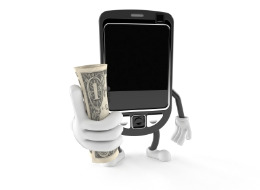 Considering that most people would rather lose their wallet than misplace their cell phone, it’s fitting that the mobile world is quickly becoming a new hub for business. For many of us, our cell phone never leaves our side. It holds a place at the dinner table, is easily accessible in your bag’s front pocket, and often, somehow it even manages to end up sharing your pillow at night. Busy schedules mean people are often on the move and when marketers and companies can’t reach consumers at their computers, on TV, before the previews at the movies, with billboards, or magazine and newspaper ads, they must feel assured that they can still reach them on their cell phones.
Considering that most people would rather lose their wallet than misplace their cell phone, it’s fitting that the mobile world is quickly becoming a new hub for business. For many of us, our cell phone never leaves our side. It holds a place at the dinner table, is easily accessible in your bag’s front pocket, and often, somehow it even manages to end up sharing your pillow at night. Busy schedules mean people are often on the move and when marketers and companies can’t reach consumers at their computers, on TV, before the previews at the movies, with billboards, or magazine and newspaper ads, they must feel assured that they can still reach them on their cell phones.
Mobile commerce, or m-commerce, is simply the ability to conduct business transactions through a mobile device. With smartphone sales rising 49% in the first quarter of 2010, never before has it been so easy to shop, anywhere, anytime from the palm of your hand. There is an enormous amount of ongoing market research, and though there has been a variety of numbers estimated and reported, they all conclude that mobile commerce is a profitable and rapidly growing market.
By 2015, it’s estimated that shoppers from around the world will spend about $119 billion on goods and services bought via their mobile phones, according to a study by ABI Research released this past February. In the United States alone, mobile shopping rose from $396 million in 2008 to $1.2 billion in 2009, and mobile campaign spending also increased by 25 to 30% over the past year, with companies shelling out just under $313 million according to the same study. Senior Analyst Mark Beccue, said that he’s forecasting U.S. sales to reach about $2.2 billion in 2010.
Here are five mobile commerce trends to keep an eye on for the remainder of 2010.
Bargain hunting has become extremely popular with apps like RedLaser that allow users to scan product bar codes and discover it’s various prices at different retailers. Shoppers are melding the two worlds of online/mobile shopping with actual physical shopping to make sure they get the best prices.
Websites like Fandango and MovieTickets.com have made snagging seats to the hottest movie of the moment that much easier (or more competitive) with their mobile ticketing apps. This past weekend, Inception, starring Leonardo DiCaprio, was sold out all weekend, but mobile ticketing likely helped movie goers nab those last few seats. And industry sources say that mobile ticketing can account for up to 10% of ticket sales for blockbusters like Avatar on opening weekend. “It’s a small but growing percent of overall ticket sales,” said Harry Medved, director of marketing at Fandango
We’ve been getting used to mobile banking for a while now. Most of us have our accounts setup online and check our balances on the phone. But according to data released by comScore, 13.2 million people accessed their bank accounts from their phones during the month of April alone, which is a 70% increase from a year ago. And similarly, the number of people using mobile banking apps more than doubled, to about 5 million in the last year.
So what are people actually buying with their phones? According to a survey by the Mobile Marketing Association, 17% of mobile commerce was used for purchasing applications and ringtones, while another 6% of people used their phones for discounts and coupons, and another 6% used their phones to buy tangible goods — that is, actual goods that you can put in your hands.
Mobile commerce is growing and it is directly related to the amount of mobile marketing that companies are investing in. A reported 74% of online retailers either have in place or are developing mobile commerce strategies, while 20% have already implemented their complete plans, according to a study by the National Retail Federation.
Source: Mashable.com

